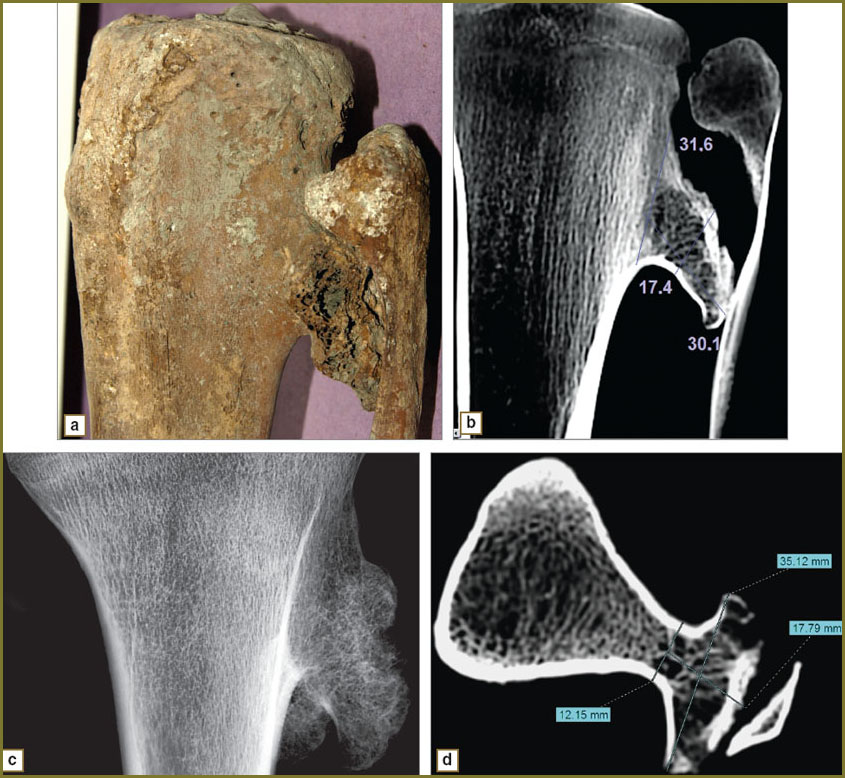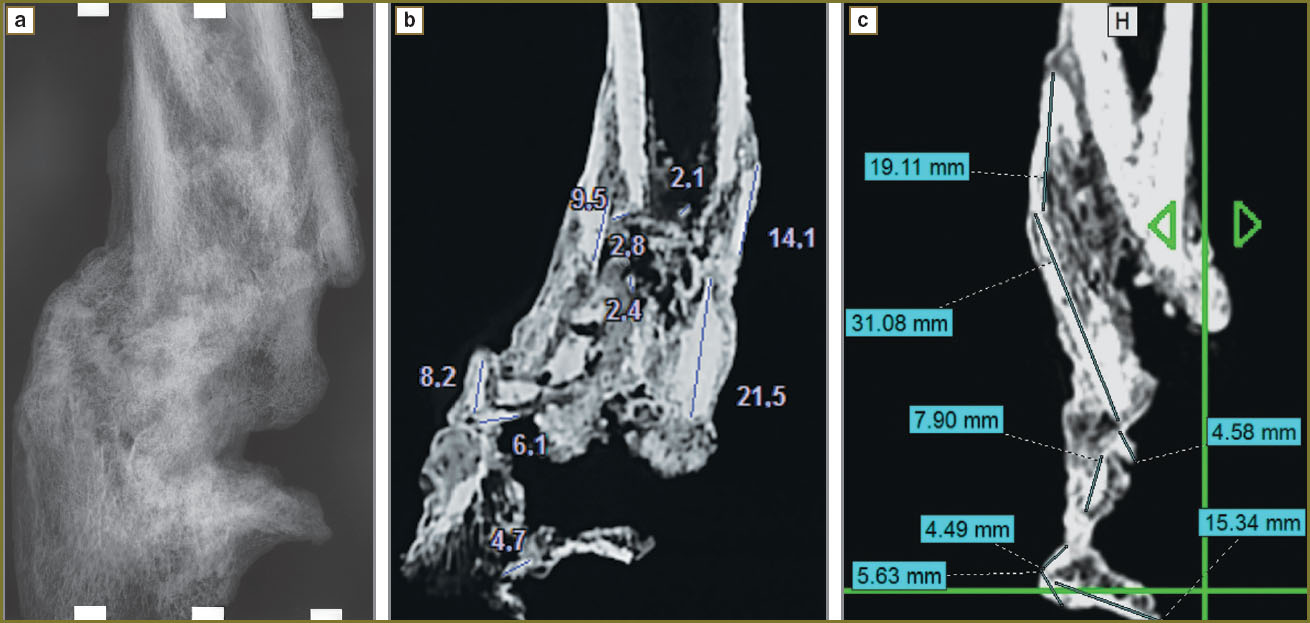The Opportunities of Modern Radiodiagnostic Methods in Expert Evaluation of Anthropological Material
The aim of the investigation was to assess the opportunities of carrying out an expert examination of bone material of the soldier remains of the Imperial army of Napoleon Bonaparte using modern radiodiagnostic methods. The expert examination aimed at the assessment of the fragments structure; the determination of the nature and incidence of bone and joint diseases; imaging and localization of foreign bodies with metal density of both primary and secondary gunshot wounds and saber cuts.
Materials and Methods. 24 bone fragments presented by Museum of Anthropology named after D.N. Anuchin, Lomonosov Moscow State University, were studied using cone-beam computed tomography (CBCT), multidetector computed tomography (MDCT) and digital microfocus radiography with direct multiple image magnification.
Results. The examination revealed the signs of inflammatory bone diseases, wrong consolidated and non-accrete fractures. We stated the nature of injuries in 37.5% of cases, and managed to characterize in detail the features of amputation stumps of limbs in 16.7% of cases. Space-occupying lesions were revealed in 4.2%.
Conclusion. The findings prove the necessity of applying modern radiadiagnostic methods with a wide range of possibilities of image post-processing to characterize battle damage of past wars. Cone-beam computed tomography can be used as a priority method in the assessment of structure and prevalence of pathological changes of bone tissue.
X-ray application in anthropology has been mentioned as far back as in the early 20th century. Currently, remains are increasingly frequently examined by modern radiodiagnostic methods [1–3]. There have appeared a few reports about anthropological material assessed by such X-ray techniques as conventional and microfocus roentgenography, multidetector computed tomography (MDCT) [4–6].
Due to the advent of cone-beam computed tomographs it became possible to examine remains by high-quality images [7]. Cone-beam computed tomography (CBCT) is based on the scanning of a study object using a pulsed X-ray beam. A specific characteristic of the technique is a primary 3D high-resolution image followed by multiplanar remodeling.
Within the framework of French Russian project on reconstruction of Napoleon Bonaparte Imperial Army death in 1812, we examined bone material of soldier remains using modern radiological methods.
The aim of the investigation was to assess the possibilities of carrying out an expert examination of bone material of the soldier remains of the Imperial army of Napoleon Bonaparte using modern radiodiagnostic methods.
The expert examination aimed at: 1) the assessment of the fragments structure; 2) the determination of the nature and incidence of bone and joint diseases; 3) imaging and localization of foreign bodies with metal density of both primary and secondary gunshot wounds and saber cuts.
Materials and Methods. The material for study was presented by Museum of Anthropology named after D.N. Anuchin, Lomonosov Moscow State University (Russia).
24 bone fragments were studied using CBCT on NewTom 5G (QR S.r.l., Italy) followed by multiplanar remodeling. The obtained data were compared with those acquired by MDCT and digital microfocus radiography with direct multiple magnification using Pardus apparatus (Russia). Photos of all study objects were taken.
CBCT imaging is based on scanning the area of interest using an X-ray pulse beam collimated in such a way that irradiation has pyramid-like propagation. Further, tissue attenuated radiation comes on a detector. Due to this technique, just one rotation of a detector tube around a study object results in 3D image ready for further processing. Cone-beam system enables to avoid imaging information loss in section gaps that is a significant factor in anthropological material examination.
Technical characteristics became an undeniable advantage when choosing a cone-beam computerized tomograph:
size of a flat detector made of amorphous silicon — 20×25 cm (detector’s size is maximal compared to other detectors of this type);
maximum trapping field — 16×18 cm;
focal spot — 0.3 mm;
Gantry rotation around a test object — 360°;
voxel — from 75 µm.
Results and Discussion. The study revealed 87.5% cases (n=21) to have signs of inflammatory bone diseases in the fragments of linear or onion-skinning periosteal reaction, sequestral cavities with fuzzy inner contours and intracavitary sequesters (more frequently, cortical). In some cases fustulous passages were seen. There were marrowy canal strictures, cortical plate thickening due to endosteal and periosteal components.
The examination of 41.7% skeletal frame (n=10) showed wrong consolidated and non-accrete fractures (Fig. 1, а–d).
We found out the nature of injuries in 37.5% cases (n=9). In a number of cases with multi-fragment fractures there were the signs of metal impregnation of bone fragment edges. There we found numerous foreign bodies with metal density, round-shaped, with clear, smooth contours, up to 2.6 mm in size, located both deep in cortical plates and in lumens of marrowy canals of skeletal frames (Fig. 2, а–d; 3, а, b).
We described in detail the characteristics of amputation stump in 20.8% cases (n=5). In three cases the extremity was amputated at the level of middle third of humeral and tibial diaphysis, in two cases — at the level of lower third of tibial diaphysis. A multicenter study of skeletal frames reliably revealed stump diseases: osteomyelitis signs and limiting cranial osteophyte that can be the evidence of technical errors when performing operations and wound infection.
In four cases bonesaw-lines had a clear, smooth contour and were square-shaped. Moreover, there was radiologically studied the right humerus consisting of two fragments compared at bonesaw-line level. We could visualize smooth, square-shaped contours.
The analysis of the right humeral stump images reliably showed hyperostosis signs and a compact an endplate of linear form, with clear, smooth contour, completely overlapping a marrowy canal. A lateral bonesaw-line was found to have a boundary cranial osteophyte (Fig. 4, а–d).
Among fragments of skeletal frames with battle damage signs in 4.2% (n=1) cases we revealed mass lesions that appeared to be incidental findings (Fig. 5, a–d). Radiological findings are likely to be consistent with osteochondroma of proximal tibial metaepiphysis.
The analysis of study findings using digital microfocus radiography with direct multiple magnification, MDCT and CBCT indicates a high quality of cone-beam computed tomograms. In certain cases these images are as good as MDCT images. By MDCT and CBCT there were reliably determined metal-density fragments, 1.0 mm and more in size, which were not seen using digital microfocus radiography with direct multiple magnification (Fig. 6, a–d).
MDCT and CBCT enable to visualize small bone fragments and the areas of pathological remodeling of bone tissue, less than 3.0 mm in size, specify their localization and spatial location. Digital microfocus radiography with multiple magnification failed to reveal reliably the above mentioned changes (Fig. 7, а–c).
Multipurpose use of modern radiodiagnostic techniques enabled to reveal true ankylosis, the areas of inflammatory destruction, up to 3.0 mm in size, and trace the fracture line length and periosteal reaction. It should be noted that bony ankylosis signs are reliably imaged using each of the mentioned techniques. MDCT images appeared to be the most informative to find the abovementioned changes (Fig. 8, а–c).
Conclusion. The findings prove the necessity of applying modern radiodiagnostic methods with a wide range of possibilities of image post-processing to characterize battle damage of past wars.
Cone-beam computed tomography enables to obtain high-quality images of fragments of skeletal frames,assess their structure, reliably determine the presence of metal-density fragments sized 1.0 mm and more, reveal bony ankylosis signs, trace the fracture line length and periosteal reaction, visualize small bone fragments and the areas of pathological remodeling of bone tissue, less than 3.0 mm in size, specify their localization and spatial location.
Considering the fact that images taken by means of cone-beam computed tomography are comparable to multidetector computed tomograms, cone-beam computed tomography can be used as a priority method in the assessment of structure and prevalence of pathological changes of bone tissue.
Study Funding and Competing Interest. This study was not supported by any financial sources and there is no topic specific conflict of interest related to the authors of this study.
References
- Buzhilova A.P., Dobrovol’skaja M.V., Mednikova M.B., Potrahov N.N., Potrahov E.N., Grjaznov A.Ju. Primenenie mikrofokusnoy rentgenografii pri diagnostike zabolevaniy drevnego cheloveka [Application of microfocus roentgenography in diagnostics of diseases of an ancient man]. Peterburgskij zhurnal jelektroniki — Saint Petersburg Journal of Electronics 2008.
- Buzhilova A.P., Berezina N.Ja., Selezneva V.I. Novye nakhodki iz kollektsii Rokhlina: rentgenologicheskiy analiz obraztsov iz paleopatologicheskogo fonda MAE RAN [New findings from the collection of Rokhlin: roentgenological analysis of samples from the Paleopatological Fund of MAE RAS]. Jelektronnaja biblioteka Muzeja antropologii i jetnografii im. Petra Velikogo (Kunstkamera) RAN — Electronic library of Peter the Great Museum of Anthropology and Ethnology (the Kunstkamera Museum) of RAS, http://www.kunstkamera.ru/lib/rubrikator/08/08_02/978-5-88431-238-8/.
- Coopersmith H. How X-rays demystified a 2,500-year-old battle wound. LiveScience’s Expert Voices: Op-Ed & Insights 2013; Jul 02, http://www.livescience.com/37929-deadly-barbed-arrowhead-revealed-by-xray.html.
- Vasil’ev A.Ju., Bulanova I.M., Buzhilova A.P., Mednikova M.B., Berezina N.Ja. Mikrofokusnaya rentgenografiya i spiral’naya rentgenovskaya komp’yuternaya tomografiya v raspoznavanii izmeneniy kostnoy tkani u drevnikh lyudey [Microfocus radiography and spiral x-ray computed tomography in recognition of changes of bone tissue of ancient people].Kaz Med Z — Kazan Medical Journal2010; 1: 44–48.
- Mednikova M.B. Kist’ sungirtsa (novye dannye o stroenii trubchatykh kostey) [The sungirc`s brush (new data about structure of tubular bones)]. Vestnik Moskovskogo universiteta. Serija XXIII. Antropologija — Vestnik of Moscow University. Seried XXIII. Anthropology 2012; 4: 4, http://www.antropos.msu.ru/vestnic/12_4.html.
- De Froidmont S., Grabherr S., Vaucher P., De Cesare M., Egger C., Papageorgopoulou C., Roth V., Morand G., Mangin P., Uldin T. Virtual anthropology: a comparison between the performance of conventional X-ray and MDCT in investigating the trabecular structure of long bones. Forensic Sci Int 2013 Feb 10; 225(1–3): 53–59. Epub 2012 Nov 13, http://dx.doi.org/10.1016/j.forsciint.2012.10.029.
- Makarova D.V. Novye vozmozhnosti metodov luchevoy diagnostiki v antropologii. V kn.:Materialy Mezhdunar. VI konferentsii “Nevskiy radiologicheskiy forum — 2013”[New opportunities of radiodiagnostics in anthropology. In: Proceedings of International VI conference “Nevsky Radiological Forum — 2013”]. 2013; р. 318.


















